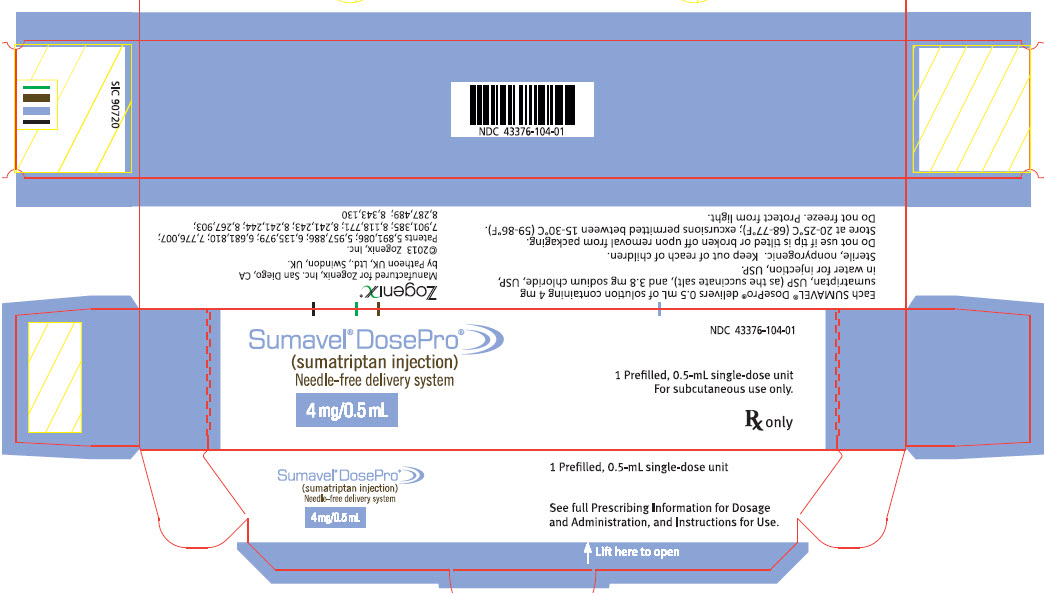SUMAVEL DOSEPRO- sumatriptan injection
Sumavel DosePro by
Drug Labeling and Warnings
Sumavel DosePro by is a Prescription medication manufactured, distributed, or labeled by Zogenix, Inc., Patheon UK Ltd. Drug facts, warnings, and ingredients follow.
Drug Details [pdf]
-
HIGHLIGHTS OF PRESCRIBING INFORMATION
These highlights do not include all the information needed to use Sumavel DosePro safely and effectively. See full prescribing information for Sumavel DosePro.
Sumavel DosePro (sumatriptan injection), for subcutaneous use
Initial U.S. Approval: 1992
INDICATIONS AND USAGE
DOSAGE AND ADMINISTRATION
- For subcutaneous use only. (2.1, 2.2)
- Acute treatment of migraine: 4 mg or 6 mg single dose. (2.1)
- Acute treatment of cluster headache: 6 mg single dose. (2.1)
- Maximum dose in a 24-hour period: 12 mg. Separate doses by at least 1 hour. (2.1)
- Administer dose only to the abdomen or thigh. (2.2)
DO NOT USE SUMAVEL DOSEPRO IF THE TIP OF THE DEVICE IS TITLED OR BROKEN OFF UPON REMOVAL FROM PACKAGING. (2.2)
DOSAGE FORMS AND STRENGTHS
- Sumavel DosePro: 4 mg or 6 mg prefilled, single-dose, needle-free subcutaneous delivery systems.
CONTRAINDICATIONS
- History of coronary artery disease or coronary vasospasm (4)
- Wolff-Parkinson-White syndrome or other cardiac accessory conduction pathway disorders (4)
- History of stroke, transient ischemic attack, or hemiplegic or basilar migraine (4)
- Peripheral vascular disease (4)
- Ischemic bowel disease (4)
- Uncontrolled hypertension (4)
- Recent (within 24 hours) use of another 5-HT1 agonist (e.g., another triptan) or of an ergotamine-containing medication (4)
- Current or recent (past 2 weeks) use of monoamine oxidase-A inhibitor
(4)
- Hypersensitivity to Sumavel DosePro (angioedema and anaphylaxis seen) (4)
WARNINGS AND PRECAUTIONS
- Myocardial ischemia/infarction and Prinzmetal’s angina: Perform cardiac evaluation in patients with multiple cardiovascular risk factors. (5.1)
- Arrhythmias: Discontinue Sumavel DosePro if occurs. (5.2)
- Chest/throat/neck/jaw pain, tightness, pressure, or heaviness: Generally not associated with myocardial ischemia; evaluate for coronary artery disease in patients at high risk. (5.3)
- Cerebral hemorrhage, subarachnoid hemorrhage, or stroke: Discontinue Sumavel DosePro if occurs. (5.4)
- Gastrointestinal ischemia or infarction events, or peripheral vasospastic reactions: Discontinue Sumavel DosePro if occurs. (5.5)
- Medication overuse headache: Detoxification may be necessary. (5.6)
- Serotonin syndrome: Discontinue Sumavel DosePro if occurs. (5.7)
- Seizures: Use with caution in patients with epilepsy or a lowered seizure threshold. (5.10)
ADVERSE REACTIONS
Most common adverse reactions (≥5% and > placebo) were injection site reactions, tingling, dizziness/vertigo, warm/hot sensation, burning sensation, feeling of heaviness, pressure sensation, flushing, feeling of tightness, and numbness. (6.1)
To report SUSPECTED ADVERSE REACTIONS, contact Zogenix, Inc. at 1-866-ZOGENIX or FDA at 1-800-FDA-1088 or www.fda.gov/medwatch.USE IN SPECIFIC POPULATIONS
- Pregnancy: Based on animal data, may cause fetal harm. (8.1)
See 17 for PATIENT COUNSELING INFORMATION and FDA-approved patient labeling.
Revised: 2/2014
- For subcutaneous use only. (2.1, 2.2)
-
Table of Contents
FULL PRESCRIBING INFORMATION: CONTENTS*
1 INDICATIONS AND USAGE
2 DOSAGE AND ADMINISTRATION
2.1 Dosing Information
2.2 Administration Using Sumavel® DosePro®
3 DOSAGE FORMS AND STRENGTHS
4 CONTRAINDICATIONS
5 WARNINGS AND PRECAUTIONS
5.1 Myocardial Ischemia, Myocardial Infarction, and Prinzmetal’s Angina
5.2 Arrhythmias
5.3 Chest, Throat, Neck, and/or Jaw Pain/Tightness/Pressure
5.4 Cerebrovascular Events
5.5 Other Vasospasm Reactions
5.6 Medication Overuse Headache
5.7 Serotonin Syndrome
5.8 Increase in Blood Pressure
5.9 Anaphylactic/Anaphylactoid Reactions
5.10 Seizures
6 ADVERSE REACTIONS
6.1 Clinical Trials Experience
7 DRUG INTERACTIONS
7.1 Ergot-Containing Drugs
7.2 Monoamine Oxidase-A Inhibitors
7.3 Other 5-HT1 Agonists
7.4 Selective Serotonin Reuptake Inhibitors/Serotonin Norepinephrine Reuptake Inhibitors and Serotonin Syndrome
8 USE IN SPECIFIC POPULATIONS
8.1 Pregnancy
8.3 Nursing Mothers
8.4 Pediatric Use
8.5 Geriatric Use
8.6 Hepatic Impairment
10 OVERDOSAGE
11 DESCRIPTION
12 CLINICAL PHARMACOLOGY
12.1 Mechanism of Action
12.2 Pharmacodynamics
12.3 Pharmacokinetics
13 NONCLINICAL TOXICOLOGY
13.1 Carcinogenesis, Mutagenesis, Impairment of Fertility
13.2 Animal Toxicology and/or Pharmacology
14 CLINICAL STUDIES
14.1 Migraine
14.2 Cluster Headache
16 HOW SUPPLIED/STORAGE AND HANDLING
17 PATIENT COUNSELING INFORMATION
- * Sections or subsections omitted from the full prescribing information are not listed.
-
1 INDICATIONS AND USAGE
Sumavel DosePro is indicated in adults for (1) the acute treatment of migraine, with or without aura, and (2) the acute treatment of cluster headache.
Limitations of Use:- Use only if a clear diagnosis of migraine or cluster headache has been established.
- If a patient has no response to the first migraine attack treated with Sumavel DosePro, reconsider the diagnosis of migraine before Sumavel DosePro is administered to treat any subsequent attacks.
- Sumavel DosePro is not indicated for the prevention of migraine attacks.
- Use only if a clear diagnosis of migraine or cluster headache has been established.
-
2 DOSAGE AND ADMINISTRATION
2.1 Dosing Information
The maximum single recommended dose of Sumavel DosePro for the acute treatment of migraine or cluster headache is 6 mg given subcutaneously. For the treatment of migraine, if side effects are dose limiting, a lower dose (4 mg) may be used [see Clinical Studies (14.1)]. For the treatment of cluster headache, the efficacy of a lower dose has not been established.
The maximum cumulative injected dose that may be given in 24 hours is 12 mg, with doses of Sumavel DosePro separated by at least 1 hour. Sumavel DosePro may be given at least 1 hour following a dose of another sumatriptan product. A second dose should only be considered if some response to a first dose was observed.
2.2 Administration Using Sumavel® DosePro®
Sumavel DosePro is available for use as 4 mg or 6 mg needle-free delivery systems. It is intended to be given subcutaneously only. Sumavel DosePro is designed for patient self-administration to sites on the abdomen or the thigh with an adequate subcutaneous thickness to accommodate penetration of sumatriptan injection into the subcutaneous space. Administration should not be made within 2 inches of the naval. Sumavel DosePro is not to be administered to other areas of the body, including the arm.
Instruct patients on the proper use of Sumavel DosePro and direct them to use proper injection sites. Patients should be instructed not to use Sumavel DosePro if the tip of the device is tilted or broken off upon removal from packaging [see Patient counseling Information (17)].
Sumavel DosePro is for single use only. Discard after use.
- 3 DOSAGE FORMS AND STRENGTHS
-
4 CONTRAINDICATIONS
Sumavel DosePro is contraindicated in patients with:
- Ischemic coronary artery disease (CAD) (angina pectoris, history of myocardial infarction, or documented silent ischemia) or coronary artery vasospasm, including Prinzmetal’s angina [see Warnings and Precautions (5.1)]
- Wolff-Parkinson-White syndrome or arrhythmias associated with other cardiac accessory conduction pathway disorders [see Warnings and Precautions (5.2)]
- History of stroke or transient ischemic attack (TIA) because these patients are at a higher risk of stroke [see Warnings and Precautions (5.4)]
- History of hemiplegic or basilar migraine
- Peripheral vascular disease [see Warnings and Precautions (5.5)]
- Ischemic bowel disease [see Warnings and Precautions (5.5)]
- Uncontrolled hypertension [see Warnings and Precautions (5.8)]
- Recent (i.e., within 24 hours) use of ergotamine-containing medication, ergot-type medication (such as dihydroergotamine or methysergide), or another 5-hydroxytryptamine1 (5-HT1) agonist [see Drug Interactions (7.1, 7.3)]
- Concurrent administration of a monamine oxidase (MAO)-A inhibitor or recent (within 2 weeks) use of an MAO-A inhibitor [see Drug Interactions (7.2) and Clinical Pharmacology (12.3)]
- Hypersensitivity to Sumavel DosePro (angioedema and anaphylaxis seen) [see Warnings and Precautions (5.9) and Adverse Reactions (6)]
- Ischemic coronary artery disease (CAD) (angina pectoris, history of myocardial infarction, or documented silent ischemia) or coronary artery vasospasm, including Prinzmetal’s angina [see Warnings and Precautions (5.1)]
-
5 WARNINGS AND PRECAUTIONS
5.1 Myocardial Ischemia, Myocardial Infarction, and Prinzmetal’s Angina
Sumavel DosePro is contraindicated in patients with ischemic or vasospastic CAD. There have been rare reports of serious cardiac adverse reactions, including acute myocardial infarction, occurring within a few hours following administration of Sumavel DosePro. Some of these reactions occurred in patients without known CAD. Sumavel DosePro may cause coronary artery vasospasm (Prinzmetal’s angina), even in patients without a history of CAD.
Perform a cardiovascular evaluation in triptan-naive patients who have multiple cardiovascular risk factors (e.g., increased age, diabetes, hypertension, smoking, obesity, strong family history of CAD) prior to receiving Sumavel DosePro. If there is evidence of CAD or coronary artery vasospasm, Sumavel DosePro is contraindicated. For patients with multiple cardiovascular risk factors who have a negative cardiovascular evaluation, consider administering the first dose of Sumavel DosePro in a medically supervised setting and performing an electrocardiogram (ECG) immediately following Sumavel DosePro. For such patients, consider periodic cardiovascular evaluation in intermittent long-term users of Sumavel DosePro.
5.2 Arrhythmias
Life-threatening disturbances of cardiac rhythm, including ventricular tachycardia and ventricular fibrillation leading to death, have been reported within a few hours following the administration of 5-HT1 agonists. Discontinue Sumavel DosePro if these disturbances occur. Sumavel DosePro is contraindicated in patients with Wolff-Parkinson-White syndrome or arrhythmias associated with other cardiac accessory conduction pathway disorders.
5.3 Chest, Throat, Neck, and/or Jaw Pain/Tightness/Pressure
Sensations of tightness, pain, pressure, and heaviness in the precordium, throat, neck, and jaw commonly occur after treatment with Sumavel DosePro and are usually non-cardiac in origin. However, perform a cardiac evaluation if these patients are at high cardiac risk. The use of Sumavel DosePro is contraindicated in patients shown to have CAD and those with Prinzmetal’s variant angina.
5.4 Cerebrovascular Events
Cerebral hemorrhage, subarachnoid hemorrhage, and stroke have occurred in patients treated with 5-HT1 agonists, and some have resulted in fatalities. In a number of cases, it appears possible that the cerebrovascular events were primary, the 5-HT1 agonist having been administered in the incorrect belief that the symptoms experienced were a consequence of migraine when they were not. Also, patients with migraine may be at increased risk of certain cerebrovascular events (e.g., stroke, hemorrhage, TIA). Discontinue Sumavel DosePro if a cerebrovascular event occurs.
Before treating headaches in patients not previously diagnosed as migraineurs, and in migraineurs who present with atypical symptoms, exclude other potentially serious neurological conditions. Sumavel DosePro is contraindicated in patients with a history of stroke or TIA.
5.5 Other Vasospasm Reactions
Sumavel DosePro, may cause non-coronary vasospastic reactions, such as peripheral vascular ischemia, gastrointestinal vascular ischemia and infarction (presenting with abdominal pain and bloody diarrhea), splenic infarction, and Raynaud’s syndrome. In patients who experience symptoms or signs suggestive of non-coronary vasospasm reaction following the use of any 5-HT1 agonist, rule out a vasospastic reaction before receiving additional doses of Sumavel DosePro.
Reports of transient and permanent blindness and significant partial vision loss have been reported with the use of 5-HT1 agonists. Since visual disorders may be part of a migraine attack, a causal relationship between these events and the use of 5-HT1 agonists have not been clearly established.
5.6 Medication Overuse Headache
Overuse of acute migraine drugs (e.g., ergotamine, triptans, opioids, or combination of these drugs for 10 or more days per month) may lead to exacerbation of headache (medication overuse headache). Medication overuse headache may present as migraine-like daily headaches or as a marked increase in frequency of migraine attacks. Detoxification of patients, including withdrawal of the overused drugs, and treatment of withdrawal symptoms (which often includes a transient worsening of headache) may be necessary.
5.7 Serotonin Syndrome
Serotonin syndrome may occur with Sumavel DosePro, particularly during co-administration with selective serotonin reuptake inhibitors (SSRIs), serotonin norepinephrine reuptake inhibitors (SNRIs), tricyclic antidepressants (TCAs), and MAO inhibitors [see Drug Interactions (7.4)]. Serotonin syndrome symptoms may include mental status changes (e.g., agitation, hallucinations, coma), autonomic instability (e.g., tachycardia, labile blood pressure, hyperthermia), neuromuscular aberrations (e.g., hyperreflexia, incoordination), and/or gastrointestinal symptoms (e.g., nausea, vomiting, diarrhea). The onset of symptoms usually occurs within minutes to hours of receiving a new or a greater dose of a serotonergic medication. Discontinue Sumavel DosePro if serotonin syndrome is suspected.
5.8 Increase in Blood Pressure
Significant elevation in blood pressure, including hypertensive crisis with acute impairment of organ systems, has been reported on rare occasions in patients treated with 5-HT1 agonists, including patients without a history of hypertension. Monitor blood pressure in patients treated with Sumavel DosePro. Sumavel DosePro is contraindicated in patients with uncontrolled hypertension.
5.9 Anaphylactic/Anaphylactoid Reactions
There have been reports of anaphylaxis, anaphylactoid, and hypersensitivity reactions including angioedema in patients receiving Sumavel DosePro. Such reactions can be life threatening or fatal. In general, anaphylactic reactions to drugs are more likely to occur in individuals with a history of sensitivity to multiple allergens. Sumavel DosePro is contraindicated in patients with a history of hypersensitivity reaction to Sumavel DosePro.
5.10 Seizures
Seizures have been reported following administration of Sumavel DosePro. Some have occurred in patients with either a history of seizures or concurrent conditions predisposing to seizures. There are also reports in patients where no such predisposing factors are apparent. Sumavel DosePro should be used with caution in patients with a history of epilepsy or conditions associated with a lowered seizure threshold.
-
6 ADVERSE REACTIONS
The following adverse reactions are discussed in more detail in other sections of the labeling:
- Myocardial ischemia, myocardial infarction, and Prinzmetal’s angina [see Warnings and Precautions (5.1)]
- Arrhythmias [see Warnings and Precautions (5.2)]
- Chest, throat, neck, and/or jaw pain/tightness/pressure [see Warnings and Precautions (5.3)]
- Cerebrovascular events [see Warnings and Precautions (5.4)]
- Other vasospasm reactions [see Warnings and Precautions (5.5)]
- Medication overuse headache [see Warnings and Precautions (5.6)]
- Serotonin syndrome [see Warnings and Precautions (5.7)]
- Increase in blood pressure [see Warnings and Precautions (5.8)]
- Hypersensitivity reactions [see Contraindications (4) and Warnings and Precautions (5.9)]
- Seizures [see Warnings and Precautions (5.10)]
6.1 Clinical Trials Experience
Because clinical trials are conducted under widely varying conditions, adverse reaction rates observed in the clinical trials of a drug cannot be directly compared with rates in the clinical trials of another drug and may not reflect the rates observed in practice.
Migraine Headache: Table 1 lists adverse reactions that occurred in 2 US placebo-controlled clinical trials in migraine subjects [see Clinical Studies (14.1)] following either a single 6 mg dose of sumatriptan injection or placebo. Only reactions that occurred at a frequency of 2% or more in groups treated with sumatriptan injection 6 mg and that occurred at a frequency greater than the placebo group are included in Table 1.
Table 1. Adverse Reactions Reported by at Least 2% of Subjects and at a Greater Frequency Than Placebo in 2 Placebo-Controlled Migraine Clinical Trialsa Percent of Subjects Reporting Adverse Reaction Sumatriptan Injection
6 mg Subcutaneous
(n = 547)Placebo
(n = 370)Atypical sensations
Tingling
Warm/hot sensation
Burning sensation
Feeling of heaviness
Pressure sensation
Feeling of tightness
Numbness
Feeling strange
Tight feeling in head42
14
11
7
7
7
5
5
2
29
3
4
<1
1
2
<1
2
<1
<1Cardiovascular
Flushing
7
2Chest discomfort
Tightness in chest
Discomfort: nasal cavity/sinuses5
3
21
<1
<1Injection site reactionb 59 24 Miscellaneous
Jaw discomfort
2
0Musculoskeletal
Weakness
Neck pain/stiffness
Myalgia
5
5
2
<1
<1
<1Neurological
Dizziness/vertigo
Drowsiness/sedation
Headache
12
3
2
4
2
<1Skin
Sweating
2
1a The sum of percentages cited is greater than 100% because subjects may have experienced more than 1 type of adverse reaction. Only reactions that occurred at a frequency of 2% or more in groups treated with sumatriptan injection and occurred at a frequency greater than that of the placebo group are included.
b Includes injection site pain, stinging/burning, swelling, erythema, bruising, bleeding.The incidence of adverse reactions in controlled clinical trials was not affected by gender or age of the subjects. There were insufficient data to assess the impact of race on the incidence of adverse reactions.
Cluster Headache: In the controlled clinical trials assessing the efficacy of sumatriptan injection as a treatment for cluster headache [see Clinical Studies (14.2)], no new significant adverse reactions were detected that had not already been identified in trials of sumatriptan in subjects with migraine.
Overall, the frequency of adverse reactions reported in the trials of cluster headache was generally lower than in the migraine trials. Exceptions include reports of paresthesia (5% sumatriptan, 0% placebo), nausea and vomiting (4% sumatriptan, 0% placebo), and bronchospasm (1% sumatriptan, 0% placebo).
- Myocardial ischemia, myocardial infarction, and Prinzmetal’s angina [see Warnings and Precautions (5.1)]
-
7 DRUG INTERACTIONS
7.1 Ergot-Containing Drugs
Ergot-containing drugs have been reported to cause prolonged vasospastic reactions. Because these effects may be additive, use of ergotamine-containing or ergot-type medications (like dihydroergotamine or methysergide) and Sumavel DosePro within 24 hours of each other is contraindicated.
7.2 Monoamine Oxidase-A Inhibitors
MAO-A inhibitors increase systemic exposure by 2-fold. Therefore, the use of Sumavel DosePro in patients receiving MAO-A inhibitors is contraindicated [see Clinical Pharmacology (12.3)].
7.3 Other 5-HT1 Agonists
Because their vasospastic effects may be additive, co-administration of Sumavel DosePro and other 5-HT1 agonists (e.g., triptans) within 24 hours of each other is contraindicated.
7.4 Selective Serotonin Reuptake Inhibitors/Serotonin Norepinephrine Reuptake Inhibitors and Serotonin Syndrome
Cases of serotonin syndrome have been reported during co-administration of triptans and SSRIs, or SNRIs, SNRIs, TCAs, and MAO inhibitors [see Warnings and Precautions (5.7)].
-
8 USE IN SPECIFIC POPULATIONS
8.1 Pregnancy
Pregnancy Category C: There are no adequate and well-controlled trials of sumatriptan injection in pregnant women. Sumavel DosePro should be used during pregnancy only if the potential benefit justifies the potential risk to the fetus.
When sumatriptan was administered intravenously to pregnant rabbits daily throughout the period of organogenesis, embryolethality was observed at doses at or close to those producing maternal toxicity. These doses were less than the maximum recommended human dose (MRHD) of 12 mg/day on a mg/m2 basis. Oral administration of sumatriptan to rabbits during organogenesis was associated with increased incidences of fetal vascular and skeletal abnormalities. The highest no-effect dose for these effects was 15 mg/kg/day. The intravenous administration of sumatriptan to pregnant rats throughout organogenesis at doses that are approximately 10 times the MRHD on a mg/m2 basis, did not produce evidence of embryolethality. The subcutaneous administration to pregnant rats prior to and throughout pregnancy did not produce evidence of embryolethality or teratogenicity.
8.3 Nursing Mothers
It is not known whether sumatriptan is excreted in human breast milk following subcutaneous administration. Because many drugs are excreted in human milk, and because of the potential for serious adverse reactions in nursing infants from Sumavel DosePro, a decision should be made whether to discontinue nursing or to discontinue the drug, taking into account the importance of the drug to the mother.
8.4 Pediatric Use
Safety and effectiveness of sumatriptan injection in pediatric patients under 18 years of age have not been established; therefore, sumatriptan injection is not recommended for use in patients under 18 years of age.
Two controlled clinical trials evaluated sumatriptan nasal spray (5 to 20 mg) in 1,248 adolescent migraineurs aged 12 to 17 years who treated a single attack. The trials did not establish the efficacy of sumatriptan nasal spray compared with placebo in the treatment of migraine in adolescents. Adverse reactions observed in these clinical trials were similar in nature to those reported in clinical trials in adults.
Five controlled clinical trials (2 single-attack trials, 3 multiple-attack trials) evaluating oral sumatriptan (25 to 100 mg) in pediatric subjects aged 12 to 17 years enrolled a total of 701 adolescent migraineurs. These trials did not establish the efficacy of oral sumatriptan compared with placebo in the treatment of migraine in adolescents. Adverse reactions observed in these clinical trials were similar in nature to those reported in clinical trials in adults. The frequency of all adverse reactions in these subjects appeared to be both dose- and age-dependent, with younger subjects reporting reactions more commonly than older adolescents.
Postmarketing experience documents that serious adverse reactions have occurred in the pediatric population after use of subcutaneous, oral, and/or intranasal sumatriptan. These reports include reactions similar in nature to those reported rarely in adults, including stroke, visual loss, and death. A myocardial infarction has been reported in a 14-year-old male following the use of oral sumatriptan; clinical signs occurred within 1 day of drug administration. Since clinical data to determine the frequency of serious adverse reactions in pediatric patients who might receive subcutaneous, oral, or intranasal sumatriptan are not presently available, the use of sumatriptan in patients under 18 years of age is not recommended.
8.5 Geriatric Use
Clinical trials of sumatriptan injection did not include sufficient numbers of subjects aged 65 and over to determine whether they respond differently from younger subjects. Other reported clinical experience has not identified differences in responses between the elderly and younger subjects. In general, dose selection for an elderly patient should be cautious, usually starting at the low end of the dosing range, reflecting the greater frequency of decreased hepatic, renal, or cardiac function and of concomitant disease or other drug therapy.
A cardiovascular evaluation is recommended for geriatric patients who have other cardiovascular risk factors (e.g., diabetes, hypertension, smoking, obesity, strong family history of CAD) prior to receiving Sumavel DosePro [see Warnings and Precautions (5.1)].
8.6 Hepatic Impairment
The effect of severe hepatic impairment on Sumavel DosePro metabolism has not been evaluated. Sumavel DosePro is not recommended for use in patients with severe hepatic impairment [see Clinical Pharmacology (12.3)].
-
10 OVERDOSAGE
The elimination half-life of sumatriptan is about 2 hours [see Clinical Pharmacology (12.3)], and therefore monitoring of patients after overdose with subcutaneous sumatriptan should continue for at least 10 hours or while symptoms or signs persist. It is unknown what effect hemodialysis or peritoneal dialysis has on the serum concentrations of sumatriptan.
-
11 DESCRIPTION
Sumavel DosePro contains sumatriptan succinate, a selective 5-HT1B/1D receptor agonist. Sumatriptan succinate is chemically designated as 3-[2-(dimethylamino)ethyl]-N-methyl-indole-5-methanesulfonamide succinate (1:1), and it has the following structure:

The empirical formula is C14H21N3O2SC4H6O4, representing a molecular weight of 413.5. Sumatriptan succinate is a white to off-white powder that is readily soluble in water and in saline.
Sumatriptan solution is a clear, colorless to pale yellow, sterile, nonpyrogenic solution for subcutaneous delivery. Each 0.5 mL of Sumavel DosePro 8 mg/mL solution contains 4 mg of sumatriptan (base) as the succinate salt and 3.8 mg of sodium chloride, USP in Water for Injection, USP. Each 0.5 mL of Sumavel DosePro 12 mg/mL solution contains 6 mg of sumatriptan (base) as the succinate salt and 3.5 mg of sodium chloride, USP, in water for injection, USP. The pH range of both solutions is approximately 4.2 to 5.3. The osmolality of both solutions is 291 mOsmol.
Sumavel DosePro is a pre-filled, single-use, disposable, needle-free subcutaneous delivery system delivering sterile sumatriptan injection. Sumavel DosePro consists of the following components: a gray plastic handle and snap-off tip, a lavender (4 mg) or green (6 mg) lever, and a glass medication chamber that is pre-filled with 4 mg or 6 mg per 0.5 mL sumatriptan injection. Utilizing pressure from a compressed nitrogen gas source in the handle, Sumavel DosePro delivers the medication by pushing it through a small, precise hole in the glass medication chamber. The resulting stream of medication is propelled through the skin and is delivered subcutaneously without a needle, following a biphasic pressure profile.
-
12 CLINICAL PHARMACOLOGY
12.1 Mechanism of Action
Sumatriptan is the active component of Sumavel DosePro. Sumatriptan binds with high affinity to human cloned 5-HT1B/1D receptors. Sumatriptan presumably exerts its therapeutic effects in the treatment of migraine headache by binding to 5-HT1B/1D receptors located on intracranial blood vessels and sensory nerves of the trigeminal system.
Current theories proposed to explain the etiology of migraine headache suggest that symptoms are due to local cranial vasodilatation and/or to the release of sensory neuropeptides (including substance P and calcitonin gene-related peptide) through nerve endings in the trigeminal system. The therapeutic activity of sumatriptan for the treatment of migraine and cluster headaches is thought to be due to the agonist effects at the 5-HT1B/1D receptors on intracranial blood vessels (including the arterio-venous anastomoses) and sensory nerves of the trigeminal system, which result in cranial vessel constriction and inhibition of pro-inflammatory neuropeptide release.
12.2 Pharmacodynamics
Blood Pressure: Significant elevation in blood pressure, including hypertensive crisis, has been reported in patients with and without a history of hypertension [see Warnings and Precautions (5.8)].
Peripheral (Small) Arteries: In healthy volunteers (N = 18), a trial evaluating the effects of sumatriptan on peripheral (small vessel) arterial reactivity failed to detect a clinically significant increase in peripheral resistance.
Heart Rate: Transient increases in blood pressure observed in some subjects in clinical trials carried out during sumatriptan’s development as a treatment for migraine were not accompanied by any clinically significant changes in heart rate.
12.3 Pharmacokinetics
Absorption and Bioavailability: Sumavel DosePro is bioequivalent to sumatriptan needle-based injection via autoinjector at the thigh and abdomen administration sites. A sub-optimal dose may be delivered when administered to the arm and therefore, the arm is not recommended as a site of administration.
Pharmacokinetic parameters following a 6 mg subcutaneous dose of Sumavel DosePro into the thigh were determined in 32 subjects (males and females). The maximum serum concentration (Cmax) (mean ± standard deviation) was 71.9 ± 14.4 ng/mL; the time to peak concentration (Tmax) was 12 minutes after dosing (range, 4 to 20 minutes); and the terminal half-life was 103 ± 22 minutes.
Pharmacokinetic parameters following a 6 mg subcutaneous dose of Sumavel DosePro into the abdomen were determined in 35 subjects (males and females). The maximum serum concentration (Cmax) (mean ± standard deviation) was 78.6 ± 17.3 ng/mL; the time to peak concentration (Tmax) was 12 minutes after dosing (range, 6 to 20 minutes); and the terminal half-life was 102 ± 12 minutes.
Distribution: The bioavailability of sumatriptan via subcutaneous site injection to 18 healthy male subjects was 97% ± 16% of that obtained following intravenous injection. Protein binding, determined by equilibrium dialysis over the concentration range of 10 to 1,000 ng/mL, is low, approximately 14% to 21%. The effect of sumatriptan on the protein binding of other drugs has not been evaluated.
Metabolism: In vitro studies with human microsomes suggest that sumatriptan is metabolized by MAO, predominantly the A isoenzyme. Most of a radiolabeled dose of sumatriptan excreted in the urine is the major metabolite indole acetic acid (IAA) or the IAA glucuronide, both of which are inactive.
Elimination: After a single 6 mg subcutaneous dose, 22% ± 4% was excreted in the urine as unchanged sumatriptan and 38% ± 7% as the IAA metabolite.
Special Populations: Age: The pharmacokinetics of sumatriptan in the elderly (mean age: 72 years, 2 males and 4 females) and in subjects with migraine (mean age: 38 years, 25 males and 155 females) were similar to that in healthy male subjects (mean age: 30 years).
Renal Impairment: The effect of renal impairment on the pharmacokinetics of sumatriptan has not been examined.
Hepatic Impairment: The effect of mild to moderate hepatic disease on the pharmacokinetics of subcutaneously administered sumatriptan has been evaluated. There were no significant differences in the pharmacokinetics of subcutaneously administered sumatriptan in moderately hepatically impaired subjects compared with healthy controls. The pharmacokinetics of subcutaneously administered sumatriptan in patients with severe hepatic impairment has not been studied. The use of Sumavel DosePro in this population is not recommended [see Use in Specific Populations (8.6)].
Race: The systemic clearance and Cmax of sumatriptan were similar in Black (n = 34) and Caucasian (n = 38) healthy male subjects.
Drug Interaction Studies: Monoamine Oxidase-A Inhibitors: In a trial of 14 healthy females, pretreatment with an MAO-A inhibitor decreased the clearance of sumatriptan, resulting in a 2-fold increase in the area under the sumatriptan plasma concentration-time curve (AUC), corresponding to a 40% increase in elimination half-life.
-
13 NONCLINICAL TOXICOLOGY
13.1 Carcinogenesis, Mutagenesis, Impairment of Fertility
Carcinogenesis: In carcinogenicity studies, rats and mice were given sumatriptan by oral gavage. Mice were dosed for 78 weeks and rats were dosed for 104 weeks. Average exposures achieved in mice receiving the highest dose were approximately 110 times the exposure attained in humans after the maximum recommended single dose of 6 mg. The highest dose to rats was approximately 260 times the maximum single dose of 6 mg on a mg/m2 basis. There was no evidence of an increase in tumors in either species related to sumatriptan administration.
Mutagenesis: Sumatriptan was not mutagenic in the presence or absence of metabolic activation when tested in 2 gene mutation assays (the Ames test and the in vitro mammalian Chinese hamster V79/HGPRT assay). It was not clastogenic in 2 cytogenetics assays (the in vitro human lymphocyte assay and the in vivo rat micronucleus assay).
Impairment of Fertility: A fertility study (Segment I) by the subcutaneous route, during which male and female rats were dosed daily with sumatriptan prior to and throughout the mating period, has shown no evidence of impaired fertility at doses equivalent to approximately 100 times the maximum recommended single human dose of 6 mg on a mg/m2 basis. However, following oral administration, a treatment-related decrease in fertility, secondary to a decrease in mating, was seen for rats treated with 50 and 500 mg/kg/day. The no-effect dose for this finding was approximately 8 times the maximum recommended single human dose of 6 mg on a mg/m2 basis. It is not clear whether the problem is associated with the treatment of males or females or both.
13.2 Animal Toxicology and/or Pharmacology
Corneal Opacities: Dogs receiving oral sumatriptan developed corneal opacities and defects in the corneal epithelium. Corneal opacities were seen at the lowest dosage tested, 2 mg/kg/day, and were present after 1 month of treatment. Defects in the corneal epithelium were noted in a 60-week study. Earlier examinations for these toxicities were not conducted and no-effect doses were not established; however, the relative exposure at the lowest dose tested was approximately 5 times the human exposure after a 100 mg oral dose or 3 times the human exposure after a 6 mg subcutaneous dose.
Melanin Binding: In rats with a single subcutaneous dose (0.5 mg/kg) of radiolabeled sumatriptan, the elimination half-life of radioactivity from the eye was 15 days, suggesting that sumatriptan and its metabolites bind to the melanin of the eye. The clinical significance of this binding is unknown.
-
14 CLINICAL STUDIES
14.1 Migraine
In controlled clinical trials enrolling more than 1,000 subjects during migraine attacks who were experiencing moderate or severe pain and 1 or more of the symptoms enumerated in Table 3, onset of relief began as early as 10 minutes following a 6 mg sumatriptan injection. Lower doses of sumatriptan injection may also prove effective, although the proportion of subjects obtaining adequate relief was decreased and the latency to that relief is greater with lower doses. In one well-controlled study, 6 different doses of sumatriptan injection (n = 30 each group) were compared with placebo (n = 62), in a single-attack, parallel-group design, the dose response relationship was found to be as shown in Table 2.
Table 2. Proportion of Subjects with Migraine Relief and Incidence of Adverse Events by Time and by Sumatriptan Dose Dose of Sumatriptan Injection Percent Subjects with Reliefa Adverse Events Incidence (%) at 10 Minutes at 30 Minutes at 1 Hour at 2 Hours Placebo 5 15 24 21 55 1 mg 10 40 43 40 63 2 mg 7 23 57 43 63 3 mg 17 47 57 60 77 4 mg 13 37 50 57 80 6 mg 10 63 73 70 83 8 mg 23 57 80 83 93 a Relief is defined as the reduction of moderate or severe pain to no pain or mild pain after dosing without use of rescue medication. In 2 randomized, placebo-controlled clinical trials of sumatriptan injection 6 mg in 1,104 subjects with moderate or severe migraine pain, the onset of relief was less than 10 minutes. Headache relief, as defined by a reduction in pain from severe or moderately severe to mild or no headache, was achieved in 70% of the subjects within 1 hour of a single 6 mg subcutaneous dose of sumatriptan injection. Approximately 82% and 65% of subjects treated with sumatriptan 6 mg had headache relief and were pain free within 2 hours, respectively.
Table 3 shows the 1- and 2-hour efficacy results for sumatriptan injection 6 mg.
Table 3. Proportion of Subjects with Pain Relief and Relief of Migraine Symptoms After 1 and 2 Hours of Treatment 1-Hour Data Study 1 Study 2 Placebo
(n = 190)Sumatriptan Injection
6 mg
(n = 384)Placebo
(n = 180)Sumatriptan Injection
6 mg
(n = 350)Subjects with pain relief (grade 0/1) 18% 70%a 26% 70%a Subjects with no pain 5% 48%a 13% 49%a Subjects without nausea 48% 73%a 50% 73%a Subjects without photophobia 23% 56%a 25% 58%a Subjects with little or no clinical disabilityb 34% 76%a 34% 76%a 2-Hour Datac Subjects with pain relief (grade 0/1) 31% 81%a 39% 82%a Subjects with no pain 11% 63%a 19% 65%a Subjects without nausea 56% 82%a 63% 81%a Subjects without photophobia 31% 72%a 35% 71%a Subjects with little or no clinical disabilityb 42% 85%a 49% 84%a a P<0.05 versus placebo.
b A successful outcome in terms of clinical disability was defined prospectively as ability to work mildly impaired or ability to work and function normally.
c Includes patients who may have received an additional injection of the assigned treatment (placebo or sumatriptan 6 mg) 1 hour after the initial injection.Subcutaneous sumatriptan also relieved photophobia, phonophobia (sound sensitivity), nausea, and vomiting associated with migraine attacks. The efficacy of sumatriptan injection was unaffected by whether or not the migraine was associated with aura, duration of attack, gender or age of the subject, or concomitant use of common migraine prophylactic drugs (e.g., beta-blockers).
14.2 Cluster Headache
The efficacy of sumatriptan injection in the acute treatment of cluster headache was demonstrated in 2 randomized, double-blind, placebo-controlled, 2-period crossover trials. Subjects aged 21 to 65 years were enrolled and were instructed to treat a moderate to very severe headache within 10 minutes of onset. Headache relief was defined as a reduction in headache severity to mild or no pain. In both trials, the proportion of individuals gaining relief at 10 or 15 minutes was significantly greater among subjects receiving 6 mg of sumatriptan injection compared with those who received placebo (see Table 4).
Table 4. Proportion of Subjects with Cluster Headache Relief by Time Study 1 Study 2 Placebo
(n = 39)Sumatriptan Injection
6 mg
(n = 39)Placebo
(n = 88)Sumatriptan Injection
6 mg
(n = 92)Subjects with pain relief (no/mild) 5 Minutes post-injection 8% 21% 7% 23%a 10 Minutes post-injection 10% 49%a 25% 49%a 15 Minutes post-injection 26% 74%a 35% 75%a a P<0.05.
(n = Number of headaches treated.)An estimate of the cumulative probability of a subject with a cluster headache obtaining relief after being treated with either sumatriptan or placebo is presented in Figure 1.
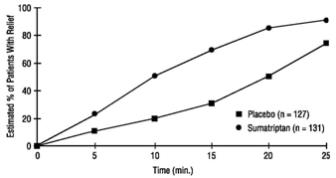
Figure 1. Time to Relief of Cluster Headache from Time of Injectiona
a The figure uses Kaplan-Meier (product limit) Survivorship Plot. Subjects taking rescue medication were censored at 15 minutes.
The plot was constructed with data from subjects who either experienced relief or did not require (request) rescue medication within a period of 2 hours following treatment. As a consequence, the data in the plot are derived from only a subset of the 258 headaches treated (rescue medication was required in 52 of the 127 placebo-treated headaches and 18 of the 131 headaches treated with sumatriptan injection).
Other data suggest that treatment with sumatriptan injection is not associated with an increase in early recurrence of headache and has little effect on the incidence of later-occurring headaches (i.e., those occurring after 2, but before 18 or 24 hours).
-
16 HOW SUPPLIED/STORAGE AND HANDLING
Each Sumavel DosePro needle-free delivery system contains sumatriptan (base) in 0.5 mL, in a sterile, nonpyrogenic solution and is supplied as follows:
- Sumavel DosePro, 4 mg in a package of six prefilled, single-dose units (NDC: 43376-104-06).
- Sumavel DosePro, 6 mg in a package of six prefilled, single-dose units (NDC: 43376-106-06).
Store at 20 oC to 25 oC (68 oF to 77 oF), with excursions permitted between 15 oC to 30 oC (59 oF to 86 oF). Do not freeze. Protect from light.
- Sumavel DosePro, 4 mg in a package of six prefilled, single-dose units (NDC: 43376-104-06).
-
17 PATIENT COUNSELING INFORMATION
See FDA-approved patient labeling.
Risk of Myocardial Ischemia and/or Infarction, Prinzmetal’s Angina, Other Vasospasm-Related Events, Arrhythmias and Cerebrovascular Events
Inform patients that Sumavel DosePro may cause serious cardiovascular side effects such as myocardial infarction or stroke. Although serious cardiovascular events can occur without warning symptoms, patients should be alert for the signs and symptoms of chest pain, shortness of breath, irregular heartbeat, significant rise in blood pressure, weakness, and slurring of speech and should ask for medical advice when observing any indicative sign or symptoms. Patients should be apprised of the importance of this follow-up [see Warnings and Precautions (5.1, 5.2, 5.4, 5.5, 5.8)].Anaphylactic/Anaphylactoid Reactions
Inform patients that anaphylactic/anaphylactoid reactions have occurred in patients receiving Sumavel DosePro. Such reactions can be life threatening or fatal. In general, anaphylactic reactions to drugs are more likely to occur in individuals with a history of sensitivity to multiple allergens [see Warnings and Precautions (5.9)].Serotonin Syndrome
Patients should be cautioned about the risk of serotonin syndrome with the use of Sumavel DosePro or other triptans, particularly during combined use with SSRIs, SNRIs, TCAs, and MAO inhibitors [see Warnings and Precautions (5.7) and Drug Interactions (7.4)].Medication Overuse Headache
Inform patients that use of acute migraine drugs for 10 or more days per month may lead to an exacerbation of headache and encourage patients to record headache frequency and drug use (e.g., by keeping a headache diary) [see Warnings and Precautions (5.6)].Pregnancy
Inform patients that Sumavel DosePro should not be used during pregnancy unless the potential benefit justifies the potential risk to the fetus [see Use in Specific Populations (8.1)].Nursing Mothers
Advise patients to notify their healthcare provider if they are breastfeeding or plan to breastfeed [see Use in Specific Populations (8.3)].Ability to Perform Complex Tasks
Since migraines or treatment with Sumavel DosePro may cause somnolence and dizziness, instruct patients to evaluate their ability to perform complex tasks during migraine attacks and after administration of Sumavel DosePro.How to Use Sumavel DosePro
Importance of Training
Patients who are to self-administer Sumavel DosePro in medically unsupervised situations should receive instruction on the proper use of Sumavel DosePro from the physician or healthcare professional prior to administering for the first time.
Patients should be made aware that a loud burst of air will be heard and a sensation felt at the time the dose is delivered via Sumavel DosePro. Patients should be advised not to use a device if the tip of the device is tilted or broken off upon removal from packaging.Choosing Administration Sites
Sumavel DosePro delivers the medication to the subcutaneous space in a manner similar to a subcutaneous injection. Since delivery is to be given subcutaneously, patients should be instructed to use administration sites on the abdomen or the thigh with adequate subcutaneous thickness to accommodate penetration of the drug into the subcutaneous space. Administration should not be made within 2 inches of the navel. Instruct patients not to administer Sumavel DosePro to the arms or other areas of the body. Inform patients that Sumavel DosePro is for subcutaneous use only and is not designed for intramuscular or intravenous use. -
PATIENT PACKAGE INSERT
Patient Information
Sumavel® DosePro® (SUE-muh-vell DOSE-pro)
(sumatriptan injection)
Needle-free Delivery SystemRead this Patient Information before you start using Sumavel DosePro and each time you get a refill. There may be new information. This information does not take the place of talking with your healthcare provider about your medical condition or treatment.
What is the most important information I should know about Sumavel DosePro? Sumavel DosePro can cause serious side effects, including:
Heart attack and other heart problems. Heart problems may lead to death.Stop taking Sumavel DosePro and get emergency medical help right away if you have any of the following symptoms of a heart attack:
- discomfort in the center of your chest that lasts for more than a few minutes, or that goes away and comes back
- severe tightness, pain, pressure, or heaviness in your chest, throat, neck, or jaw
- pain or discomfort in your arms, back, neck, jaw, or stomach
- shortness of breath with or without chest discomfort
- breaking out in a cold sweat
- nausea or vomiting
- feeling lightheaded
Sumavel DosePro is not for people with risk factors for heart disease unless a heart exam is done and shows no problem. You have a higher risk for heart disease if you:
- have high blood pressure
- have high cholesterol levels
- smoke
- are overweight
- have diabetes
- have a family history of heart disease
What is Sumavel DosePro?
Sumavel DosePro is a prescription medicine used to treat acute migraine headaches with or without aura and acute cluster headaches in adults who have been diagnosed with migraine or cluster headaches.
Sumavel DosePro is not used to treat other types of headaches such as hemiplegic (that make you unable to move on one side of your body) or basilar (rare form of migraine with aura) migraines.
Sumavel DosePro is not used to prevent or decrease the number of migraine or cluster headaches you have.
It is not known if Sumavel DosePro is safe and effective in children under 18 years of age.
Who should not take Sumavel DosePro?
Do not take Sumavel DosePro if you have:
- heart problems or a history of heart problems
- narrowing of blood vessels to your legs, arms, stomach, or kidney (peripheral vascular disease)
- uncontrolled high blood pressure
- hemiplegic migraines or basilar migraines. If you are not sure if you have these types of migraines, ask your healthcare provider.
- had a stroke, transient ischemic attacks (TIAs), or problems with your blood circulation
- taken any of the following medicines in the last 24 hours:
almotriptan (AXERT®)
eletriptan (RELPAX®)
frovatriptan (FROVA®)
naratriptan (AMERGE®)
rizatriptan (MAXALT®, MAXALT-MLT®)
ergotamines (CAFERGOT®, ERGOMAR®, MIGERGOT®)
dihydroergotamine (D.H.E. 45®, MIGRANAL®)
Ask your healthcare provider if you are not sure if your medicine is listed above.
- are allergic to sumatriptan or any of the ingredients in Sumavel DosePro. See the end of this leaflet for a complete list of ingredients in Sumavel DosePro.
What should I tell my healthcare provider before taking Sumavel DosePro?
Before you take Sumavel DosePro, tell your healthcare provider about all of your medical conditions, including if you:
- have high blood pressure
- have high cholesterol
- have diabetes
- smoke
- are overweight
- have heart problems or family history of heart problems or stroke
- have liver problems
- have had epilepsy or seizures
- are not using effective birth control
- become pregnant while taking Sumavel DosePro
- are breastfeeding or plan to breastfeed. Sumavel DosePro passes into your breast milk and may harm your baby. Talk with your healthcare provider about the best way to feed your baby if you take Sumavel DosePro.
Tell your healthcare provider about all the medicines you take, including prescription and over-the-counter medicines, vitamins, and herbal supplements.
Using Sumavel DosePro with certain other medicines can affect each other, causing serious side effects.
Especially tell your healthcare provider if you take anti-depressant medicines called:
- selective serotonin reuptake inhibitors (SSRIs)
- serotonin norepinephrine reuptake inhibitors (SNRIs)
- tricyclic antidepressants (TCAs)
- monoamine oxidase inhibitors (MAOIs)
Ask your healthcare provider or pharmacist for a list of these medicines if you are not sure.
Know the medicines you take. Keep a list of them to show your healthcare provider or pharmacist when you get a new medicine.
How should I take Sumavel DosePro?
- See the Instructions for Use at the end of this leaflet for complete information on how to use Sumavel DosePro.
- Certain people should take their first dose of Sumavel DosePro in their healthcare provider’s office or in another medical setting. Ask your healthcare provider if you should take your first dose in a medical setting.
- Use Sumavel DosePro exactly as your healthcare provider tells you to use it.
- Before you try to inject Sumavel DosePro yourself, a healthcare provider should teach you how to use the Sumavel DosePro Needle-free Delivery System.
- Your healthcare provider may change your dose. Do not change your dose without first talking to your healthcare provider.
- You should use Sumavel DosePro as soon as the symptoms of your headache start, but it may be given at any time during a migraine attack.
- If you did not get any relief after the first dose, do not give a second dose without first talking with your healthcare provider.
- You may use a second dose of Sumavel DosePro or 1 dose of another sumatriptan medicine separated by at least 1 hour, but not sooner, if your headache came back after your first dose.
- Do not use more than 2 doses of 6 mg or 3 doses of 4 mg Sumavel DosePro in a 24-hour period.
- If you use too much Sumavel DosePro, call your healthcare provider or go to the nearest hospital emergency room right away.
- You should write down when you have headaches and when you take Sumavel DosePro so you can talk with your healthcare provider about how Sumavel DosePro is working for you.
What should I avoid while taking Sumavel DosePro?
Sumavel DosePro can cause dizziness, weakness, or drowsiness. If you have these symptoms, do not drive a car, use machinery, or do anything where you need to be alert.
What are the possible side effects of Sumavel DosePro?
Sumavel DosePro may cause serious side effects, including:
-
See “What is the most important information I should know about Sumavel DosePro?”
-
stroke
-
changes in color or sensation in your fingers and toes (Raynaud’s syndrome)
-
stomach and intestinal problems (gastrointestinal and colonic ischemic events)
Symptoms of gastrointestinal and colonic ischemic events include:
sudden or severe stomach pain
stomach pain after meals
weight loss
nausea or vomiting
constipation or diarrhea
bloody diarrhea
fever
-
problems with blood circulation to your legs and feet (peripheral vascular ischemia)
Symptoms of peripheral vascular ischemia include:
cramping and pain in your legs or hips
feeling of heaviness or tightness in your leg muscles
burning or aching pain in your feet or toes while resting
numbness, tingling, or weakness in your legs
cold feeling or color changes in 1 or both legs or feet
-
medication overuse headaches. Some people who use too many Sumavel DosePro injections may have worse headaches (medication overuse headache). If your headaches get worse, your healthcare provider may decide to stop your treatment with Sumavel DosePro.
-
serotonin syndrome. Serotonin syndrome is a rare but serious problem that can happen in people using Sumavel DosePro, especially if Sumavel DosePro is used with anti-depressant medicines called SSRIs or SNRIs.
Call your healthcare provider right away if you have any of the following symptoms of serotonin syndrome:
mental changes such as seeing things that are not there (hallucinations), agitation, or coma
fast heartbeat
changes in blood pressure
high body temperature
tight muscles
trouble walking
- seizures. Seizures have happened in people taking Sumavel DosePro who have never had seizures before. Talk with your healthcare provider about your chance of having seizures while you take Sumavel DosePro.
The most common side effects of Sumavel DosePro include:
- pain or redness at your injection site
- tingling or numbness in your fingers or toes
- dizziness
- warm, hot, burning feeling to your face (flushing)
- discomfort or stiffness in your neck
- feeling weak, drowsy, or tired
Tell your healthcare provider if you have any side effect that bothers you or that does not go away.
These are not all the possible side effects of Sumavel DosePro. For more information, ask your healthcare provider or pharmacist.
Call your doctor for medical advice about side effects. You may report side effects to the FDA at 1-800-FDA-1088.
How should I store Sumavel DosePro Injection?
- Store Sumavel DosePro between 68 oF to 77 oF (20 oC to 25 oC).
- Do not freeze.
- Protect from light.
Keep Sumavel DosePro and all medicines out of the reach of children.
General information about the safe and effective use of Sumavel DosePro.
Medicines are sometimes prescribed for purposes other than those listed in Patient Information leaflets. Do not use Sumavel DosePro for a condition for which it was not prescribed. Do not give Sumavel DosePro to other people, even if they have the same symptoms you have. It may harm them.
This Patient Information leaflet summarizes the most important information about Sumavel DosePro. If you would like more information, talk with your healthcare provider. You can ask your healthcare provider or pharmacist for information about Sumavel DosePro that is written for healthcare professionals.
For more information, go to www.SumavelDosePro.com or call 1-866-ZOGENIX
What are the ingredients in Sumavel DosePro Injection?
Active ingredient: sumatriptan succinate
Inactive ingredients: sodium chloride, water for injection
Instructions for Use
Sumavel® DosePro® (SUE-muh-vell DOSE-pro)
(sumatriptan injection)
Needle-free Delivery SystemRead these Instructions for Use which come with Sumavel DosePro before you start using it and each time you get a refill. Follow these instructions each time you use Sumavel DosePro. Before you use Sumavel DosePro for the first time, make sure your doctor shows you the right way to use it.
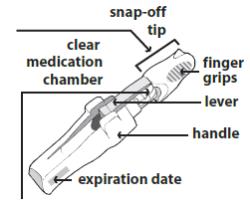
A. Check your device:
The snap-off tip should sit firmly on the end of the clear medication chamber. Do not use Sumavel DosePro if the snap-off tip is tilted or broken off.
The medicine inside Sumavel DosePro should be clear and colorless or pale yellow. Do not use Sumavel DosePro if the medicine looks dark-colored or cloudy.
The expiration date is printed on both the Sumavel DosePro label and carton. Do not use Sumavel DosePro if the medicine is expired.
B. Choose a delivery site:
Select a delivery site such as your stomach area (abdomen) or your thigh.
Do not deliver Sumavel DosePro in the arm.
Your skin should be clean, dry, and free of clothing.
Do not deliver through your clothes.
Do not deliver into scars or moles, or within 2 inches of your belly button (navel). Do not deliver into the same spot. Change delivery sites with each use.
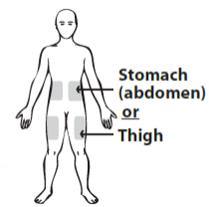
Shaded areas show all possible areas of delivery.
- Snap: In this step, you will learn how to correctly remove the snap-off tip.
Do not begin these steps until you are ready to take your dose.
Firmly hold the handle of Sumavel DosePro in one hand. With the other hand, use your fingers to grip the top and bottom of the snap-off tip where the finger grips are located.
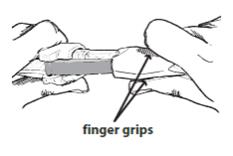
To break off the snap-off tip, firmly snap it off in a downward motion. You may need to use some force.
You do not need to twist or pull the snap-off tip; doing so will not work.
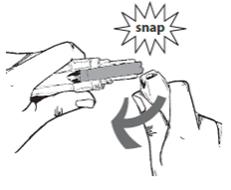
2. Flip: In this step, you will learn how to prepare Sumavel DosePro for delivery of the medicine.
Firmly press the lavender (4 mg) or green (6 mg) lever all the way down (away from the clear plastic end), until it clicks and locks into the handle. You may feel some resistance – this is normal.
Once you have flipped the lever, do not touch the end of the clear medication chamber. Keep the medication chamber pointed away from your face or eyes.
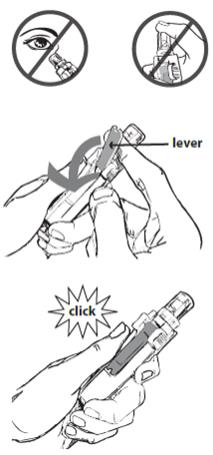
3. Pinch and Press: In this step, you will learn how to deliver the medicine.
Deliver the dose exactly as shown to you by your healthcare provider.
Pinch about 2 inches of the skin of your stomach (abdomen) or thigh to create a firm section of skin.

Place Sumavel DosePro straight out from the delivery site with the end of the clear medication chamber against your skin.
Do not hold Sumavel DosePro at an angle to your skin.
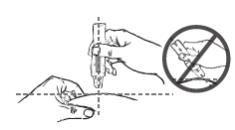
During the next step, you will hear a loud burst of air. Do not be alarmed – this indicates that the medicine has been delivered.
Steadily press Sumavel DosePro straight down against your skin until you hear and feel a burst of air. There is no button to push. After you hear the burst of air (whoosh), the medicine has been delivered and you can remove Sumavel DosePro from your skin.
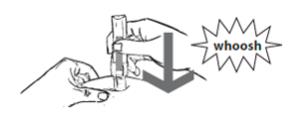
Let go of your pinched skin after the medicine has been delivered.
After removing Sumavel DosePro from your skin, a small droplet of blood may be present. You can gently press a cotton ball or gauze over the injection site. Do not rub the injection site. You may cover the injection site with a small adhesive bandage, if needed.
This Patient Information and Instructions for Use has been approved by the U.S. Food and Drug Administration.
Manufactured by Patheon UK, Limited
Swindon, United KingdomManufactured for:
Zogenix, Inc.
San Diego, CA 92130US Patent Nos. 5,891,086; 5,957,886; 6,135,979; 6,174,304; 6,251,091; 6,280,410; 6,681,810; 7,776,007; 7,901,385; 8,118,771; 8,241,243; 8,241,244; 8,267,903; 8,287,489; 8,343,130; and 8,491,524.
Sumavel® and DosePro® are registered trademarks of Zogenix, Inc.
©2014, Zogenix, Inc. All rights reserved. - discomfort in the center of your chest that lasts for more than a few minutes, or that goes away and comes back
-
PRINCIPAL DISPLAY PANEL
PRINCIPAL DISPLAY PANEL
NDC: 43376-106-01
Sumavel® DosePro
(sumatriptan injection)
Needle-free delivery system
6 mg/0.5 mL
Rx Only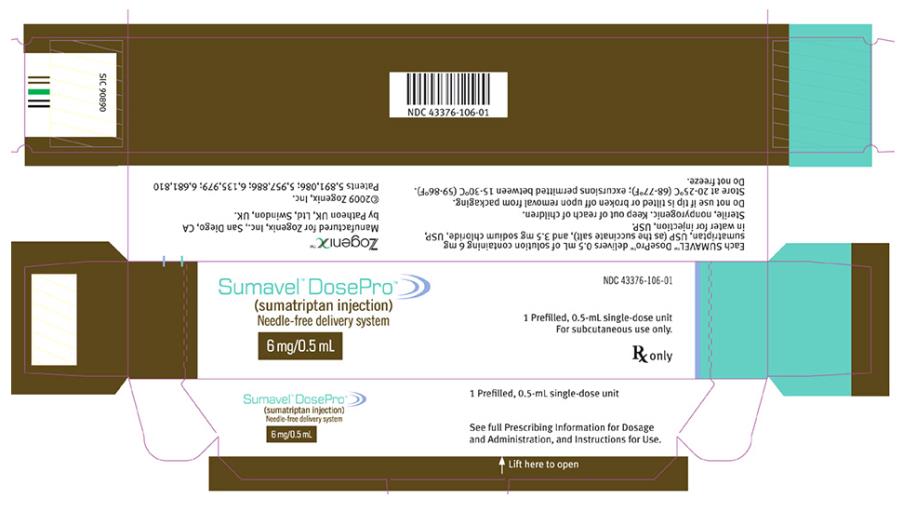
- PRINCIPAL DISPLAY PANEL
-
INGREDIENTS AND APPEARANCE
SUMAVEL DOSEPRO
sumatriptan injectionProduct Information Product Type HUMAN PRESCRIPTION DRUG Item Code (Source) NDC: 43376-106 Route of Administration SUBCUTANEOUS Active Ingredient/Active Moiety Ingredient Name Basis of Strength Strength SUMATRIPTAN SUCCINATE (UNII: J8BDZ68989) (SUMATRIPTAN - UNII:8R78F6L9VO) SUMATRIPTAN 6 mg in 0.5 mL Inactive Ingredients Ingredient Name Strength SODIUM CHLORIDE (UNII: 451W47IQ8X) WATER (UNII: 059QF0KO0R) Packaging # Item Code Package Description Marketing Start Date Marketing End Date 1 NDC: 43376-106-01 1 in 1 CARTON 1 0.5 mL in 1 SYRINGE, GLASS 2 NDC: 43376-106-51 1 in 1 CARTON 2 0.5 mL in 1 SYRINGE, GLASS 3 NDC: 43376-106-54 4 in 1 CARTON 3 0.5 mL in 1 SYRINGE, GLASS 4 NDC: 43376-106-06 6 in 1 CARTON 4 0.5 mL in 1 SYRINGE, GLASS Marketing Information Marketing Category Application Number or Monograph Citation Marketing Start Date Marketing End Date NDA NDA022239 07/15/2009 SUMAVEL DOSEPRO
sumatriptan injectionProduct Information Product Type HUMAN PRESCRIPTION DRUG Item Code (Source) NDC: 43376-104 Route of Administration SUBCUTANEOUS Active Ingredient/Active Moiety Ingredient Name Basis of Strength Strength SUMATRIPTAN SUCCINATE (UNII: J8BDZ68989) (SUMATRIPTAN - UNII:8R78F6L9VO) SUMATRIPTAN 4 mg in 0.5 mL Inactive Ingredients Ingredient Name Strength SODIUM CHLORIDE (UNII: 451W47IQ8X) WATER (UNII: 059QF0KO0R) Packaging # Item Code Package Description Marketing Start Date Marketing End Date 1 NDC: 43376-104-51 1 in 1 CARTON 1 0.5 mL in 1 SYRINGE, GLASS 2 NDC: 43376-104-01 1 in 1 CARTON 2 0.5 mL in 1 SYRINGE, GLASS 3 NDC: 43376-104-54 4 in 1 CARTON 3 0.5 mL in 1 SYRINGE, GLASS 4 NDC: 43376-104-06 6 in 1 CARTON 4 0.5 mL in 1 SYRINGE, GLASS Marketing Information Marketing Category Application Number or Monograph Citation Marketing Start Date Marketing End Date NDA NDA022239 12/04/2013 Labeler - Zogenix, Inc. (867785441) Establishment Name Address ID/FEI Business Operations Patheon UK Ltd 237710418 MANUFACTURE(43376-106, 43376-104)
© 2025 FDA.report
This site is not affiliated with or endorsed by the FDA.
